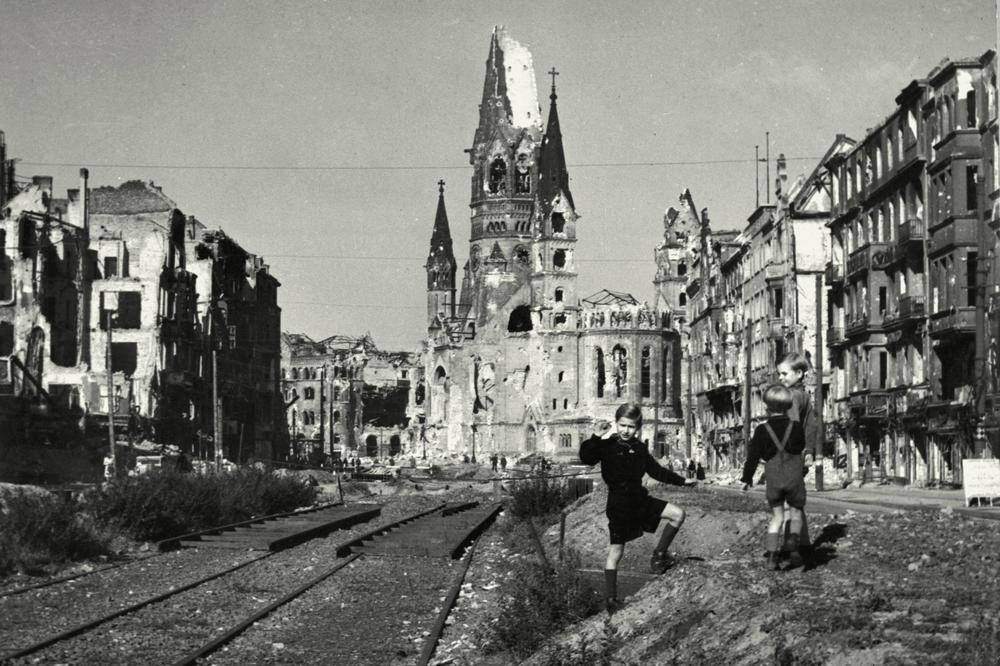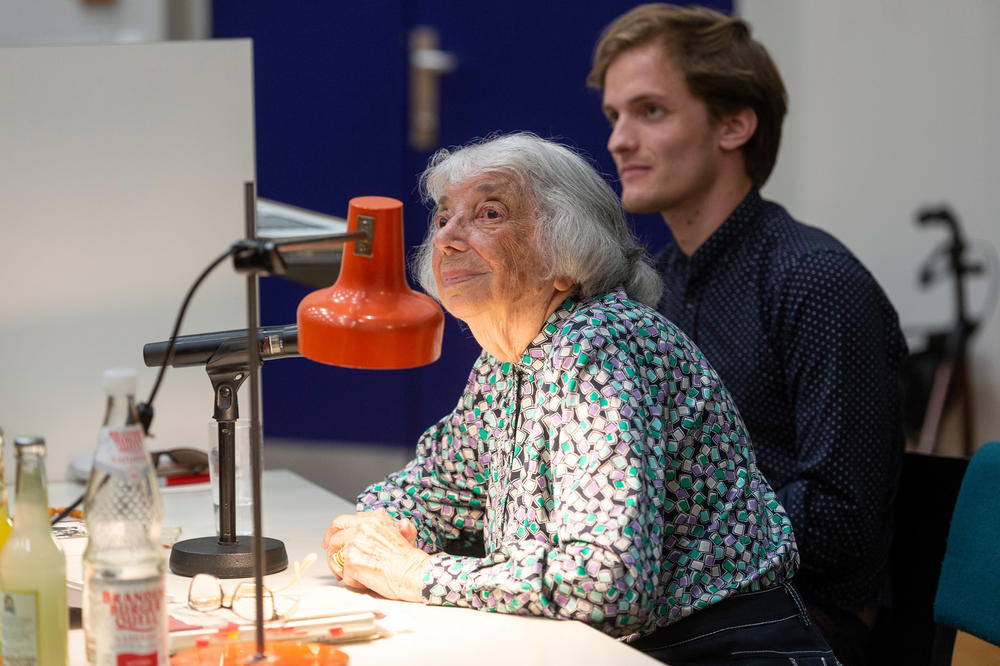Changing Memories
75 Years after the End of World War II in Europe: Digital Interview Collections Conserve Memories of Nazi Crimes
May 19, 2020
Memorial. In post-war Berlin, children played in front of the ruins of the Kaiser Wilhelm Memorial Church on the destroyed Tauentzienstrasse.
Image Credit: akg-images - Fritz Eschen
“We cannot change what happened,” says Margot Friedlander. “But it must never happen again. Never ever.” It is August 21, 2019. Friedlander, born in 1921 and a survivor of the Holocaust, speaks in front of a full auditorium at Freie Universität Berlin. She accepted an invitation from history student Vincent Bruckmann to come and read from her autobiography and answer questions, mainly from students.
It was a special meeting – and unfortunately a rare one: 75 years after the end of World War II, there are not many people left to tell about it. That is why efforts have been made for many years to record the eyewitnesses. “Using oral history is becoming more common,” says Doris Tausendfreund, who holds a doctorate in history. Since 2006, she has been on the team at the Center for Digital Systems (CeDiS) at Freie Universität that maintains the Interview Archive to make the huge collection of interviews accessible. “Interviews offer a very personal perspective and are able to touch individuals in a special way,” says Doris Tausendfreund.
Steven Spielberg Founded the Shoah Foundation
The first interviews were taped shortly after World War II ended. In the summer of 1946, an American psychologist, David P. Boder, traveled through refugee camps in Europe and spoke with more than 120 survivors of the Holocaust. However, it took some time for contemporary testimonies to be archived systematically and in large numbers. The most ambitious project goes back to the American director Steven Spielberg. In 1994, after filming Schindler's List, which exposed the crimes of National Socialism to millions of people, he founded the Shoah Foundation, which aims to interview as many contemporary witnesses as possible. To date, around 55,000 people have told their life stories in front of the camera, most of whom are survivors of the Holocaust.
Don't forget: Margot Friedlander accepted an invitation from history student Vincent Bruckmann (at right) to speak at Freie Universität.
Image Credit: Bernd Wannenmacher
For the resulting Visual History Archive and other collections of interviews, the Center for Digital Systems acquired licenses enabling all the members of the university and library visitors to have access to the recordings. Later, CeDiS designed its own collections. For the online archive “Forced Labor 1939 - 1945,” created in cooperation with the EVZ Foundation (Stiftung Erinnerung, Verantwortung und Zukunft), Doris Tausendfreund and her team created their own digital infrastructure. Now almost 600 contemporary witnesses on the subject of forced labor are documented there. These oral history interviews were conducted throughout Europe. The coordination was handled by the Institute of History and Biography at FernUniversität Hagen. The CeDiS team conducted interviews for another collection on the German occupation of Greece in World War II.
Hundreds of Videos Were Transcribed and Translated
“Life history interviews are a difficult source,” says Doris Tausendfreund. The videos are long and can be overwhelming. The CeDiS team has transcribed and translated hundreds of videos to make working with the interviews easier and to enable full-text searches. Timestamps connect texts with video passages. In the Forced Labor Archive, headlines structure the narrative. Names of people, camps, companies, and places were marked, explained, aliased, and geocoordinated with the aim of contributing to a better understanding of the interviews. Locations can be shown on maps.
Interest in the interviews available in Germany for the first time was so great that at first CeDiS offered introductory seminars every week, recalls Verena Lucia Nägel. At CeDiS she is responsible for integrating the digital collections into research and teaching. In the meantime, the University Library at Freie Universität Berlin has set up a multimedia room to give users from outside the university access to the Visual History Archive and other restricted collections. The interview collections accessible on the Internet are used even more. Around 100 new users register each month for the online archive “Forced Labor 1939 - 1945” alone. That the collections at Freie Universität are based at CeDiS is partly due to the sophisticated technology, but it is also intended to facilitate their multidisciplinary use.
Interviews Are Part of the Curriculum
“Many lecturers and students are interested in working with the interviews,” says Verena Lucia Nägel. The Visual History Archive alone has been used in around 200 seminars and lectures, and not just in history. In Jewish studies, the interviews serve to examine Jewish life in the Weimar Republic, in political science to deal with German memory policy, and in literary studies to research autobiographical narrative. The archives are also used regularly in the courses on German history offered especially for exchange students.
For the Forced Labor Archive, CeDiS developed online learning platforms for use in schools. School students can see a representative selection of carefully shortened interviews, supplemented with photos and other documents. Teachers can choose from numerous tasks or enter their own assignments. Czech, Polish, and Russian versions were also created in cooperation with universities and associations from the respective countries. Greek and Dutch versions are in preparation.
Verena Lucia Nägel points out that the collections are also often consulted for journalistic projects or research on the stumbling block (Stolperstein) initiative. A particularly great motivation for dealing with the contemporary eyewitnesses arises when one's own family is affected – whether as a perptrator or a victim. Doris Tausendfreund has observed that interest remains high regardless of the time interval. For example, that a person's great-grandfather was a forced laborer or hired forced labor to do work on his farm is a typical starting point for research into family history.
The public interest shows that history is more than just a school subject and an academic discipline. That is the idea behind the master's degree program in “Public History,” which has been offered for 12 years at Freie Universität in cooperation with the Center for Contemporary History in Potsdam (ZZF). It is the first degree program in Germany aimed at history students who want to take history to the public beyond schools and universities, for example, in memorials, adult education, or in history agencies that design and implement projects on historical topics.
Martin Lücke, who helped create the degree program, emphasizes that it is important to learn how to deal with changing sources correctly. A professor of history teaching methods, he points out the the memory of National Socialism is shifting into media memory.
Lücke warns his students against treating video interviews like real encounters. He says, “You can't bring back contemporary witnesses. The special value of videography and audio recordings is that the distance is greater than in direct conversation.” Medialization is a separate step requiring reflection in a critical use of the source. The digital collections are an important component to adequately represent the perspective of the victims.
German Culture of Remembrance
The master's degree program in “Public History” also includes debates about the German culture of remembrance. According to Lücke, this includes the historians' dispute in the 1980s over the singularity of the Holocaust as well as debates about the entanglement of the Wehrmacht in the 1990s. Currently, there are discussions as to whether our contemporary migration society has other requirements for conveying history. Martin Lücke points out that it is wrong to look for the problem in the people who have moved here, but rather that it is important to take seriously the fact that people with very different narratives are part of out society.
Historian Doris Tausendfreund sees an important strength of the digital collections in the diversity of perspectives, which are also shaped by the different countries of origin. The interviews in the Forced Labor Archive, for example, were conducted in 26 countries and 25 languages.
More digital collections are being created. CeDiS, which is now part of the University Library, is currently working on a collection of eyewitnesses of the Colonia Dignidad, a settlement founded by a German sect in 1961 in southern Chile, as well as an archive of fatal attempts to escape the Iron Curtain.
There are also plans for an open platform that would link various collections and would enable researchers to integrate their own interviews. The University Library and CeDiS have submitted a proposal to the German Research Foundation for this project. Doris Tausendfreund points out that “Interviews are an important resource against forgetting.” This is particularly true for memories of the Holocaust, which can hardly be conveyed in personal conversations 75 years after the end of the war, but which have lost none of their significance.
The original German version of this article was published on May 6, 2020, in campus.leben, the online magazine of Freie Universität Berlin.


